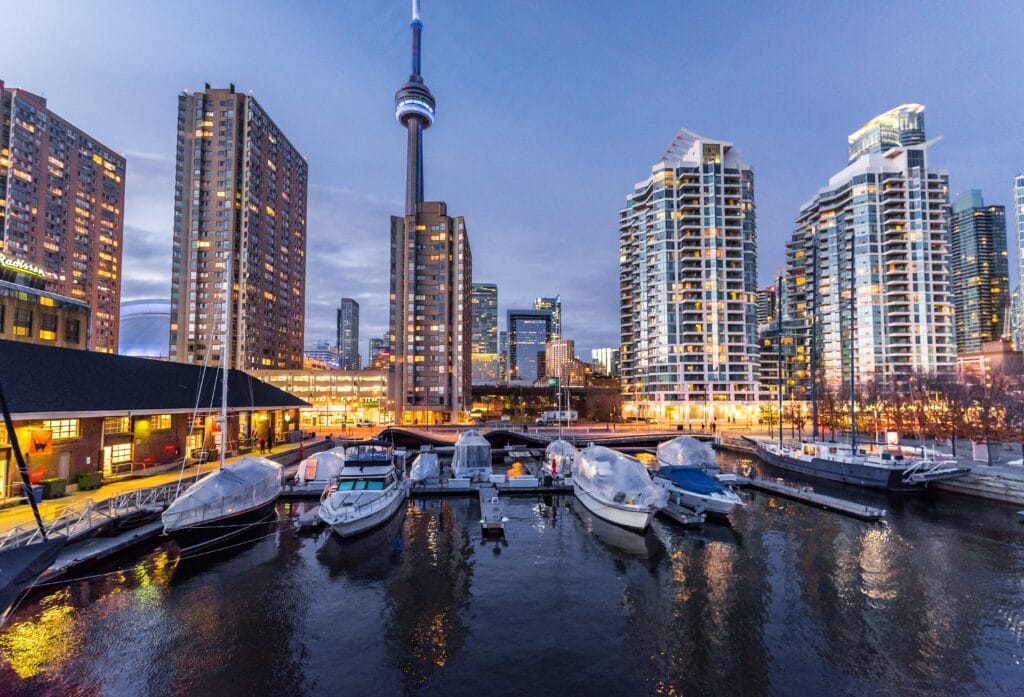
Canada is a particularly welcoming country for refugees and immigrants, and for many of them, the first step to entering the country is obtaining a Canadian visa.
To help you enter Canada, our team at Remitly put together this guide to preparing for a Canada visa application. Read on to learn what you need to know before submitting a visa application to the Canadian government, so you can get ready to visit or relocate to Canada.
What are the types of Canadian visas that allow you to enter Canada?
There are four general types of visas in Canada: the Temporary Resident Visa (Visitor visa), the Study Permit, the Work Permit, and the Permanent Resident Travel Document.
Let’s look at each type and the documents you need to complete the Canada visa application properly.
Temporary Canadian Visa
Also known as a Canada visitor visa, the Temporary Resident Visa is the visa type for people who want to visit Canada for an extended vacation, to attend an event, or stay with a family member or friend.
Documentation needed for a Temporary Resident Visa or Visitor Visa:
To apply for a visitor visa, you’ll typically need the following supporting documents:
- Fee payment (Fee list here)
- A photocopy of your passport or valid travel identification
- Two visa photos that fit the photo specifications with your name and date of birth on the back
- Proof of financial support, such as a letter from the person you’ll be staying with or a bank statement
- Photocopy of marriage license/certificate, if you’re traveling with your spouse
- Purpose of travel/visit
- Photocopy of current immigration status (visas or passport from your home country)
- Minor children traveling alone must have a letter of authorization from their parents or legal guardians
Canadian Study Permit
If you’ll be studying abroad as an international student, you’ll need to get a study permit in Canada. Your university in Canada will also provide help with the application package once you’re accepted to their institution.
Documentation needed for a Canada Study Permit:
To get a visa to enter Canada as a student, you’ll typically need the following documents:
- A passport or valid travel identification
- An acceptance letter from a designated learning institute (DLI)
- Proof that you have enough money for:
- Tuition
- Living expenses for yourself and any other family members that may live with you in Canada
- Return transportation for yourself and any family members with you in Canada
There are also a few other requirements that you may need to comply with for a study permit. To learn more about these additional requirements, visit the Canadian government’s website on study permits.

Canadian Work Permit
If you’re a temporary worker, business person, student, or caregiver in the Caregiver Live-in Program, a work permit is the type of visa you’ll typically need to enter Canada.
The work permit isn’t a Canadian visa for people visiting Canada, long-term residents, or permanent residents who hope to become Canadian citizens. Instead, it’s designed to make it easier for temporary workers from other countries to share their skills in Canada for a limited period.
Documentation needed for a Canada work permit:
- Passport or valid travel document
- Language test results
- Education credential assessment report, if
- you’re applying through the Federal Skilled Workers program, or
- you want to get points for the education you got outside of Canada
- Provincial nomination (if you have one)
- Written job offer from an employer in Canada (if you have one)
- Proof that you have a job type set out in NAFTA (for example, accountant, computer systems analyst, or engineer)
- Police certificates and criminal history background
- Medical exams proving that you are healthy
- Proof of funds for living expenses and transportation
Permanent Canadian Resident Travel Document
A permanent resident travel document allows Canadian residents who wish to leave Canada to travel and then reenter the country. It proves that the individuals are legal permanent residents and is valid for a single entry.
Documentation needed for a Permanent Canadian Resident Travel Document:
- Valid passport
- Fee payment
- Two visa photos that fit the photo specifications
- Photocopies of all previous passports or travel documents used in the last five years
- Two pieces of evidence showing residency in Canada for the last five years:
- Paystubs or employment records
- Bank statements
- Rental agreements
- Canada Revenue Agency Notice of Assessment for five years before the application
- Evidence that you have received benefits from Canadian government programs
- Marriage license or proof of common-law partnership (if traveling with spouse or partner)
- Child’s birth certificate (if traveling with child)
- Business licenses or articles of incorporation, business partnership agreements, etc.

What is proof of financial support?
For a visitor visa and other types of Canadian visas, you typically must show proof of financial support. Generally, this means six months of bank statements demonstrating that you have money in your account.
You may also wish to provide additional documents, such as an employment letter, pay stub, proof of pension, or proof of financial assets like investments.
If someone else is paying for your trip, they will need to submit documentation. For example, if a family member is covering the costs, you must send their bank statements and a copy of their passport or other photo identification.
Come to Canada: An Online Resource
Come to Canada is an online tool designed to help people discover if they need a visa and if they are eligible to apply for one. To learn more, you will answer several questions about:
- nationality
- age
- language ability
- family members
- education
- work experience
- income and/or net worth
- details on any job offer
Based on the answers to these questions, this tool can help you determine what programs you may be eligible for and which type of visa you should apply for. However, it’s best to consult an immigration lawyer to confirm exactly what you need to do for your visa application.
What is the Canada visa application process like?
Although requirements for the Canada visitor visa, work visa, and study visa are different, you typically go through the same process to apply for them. Here’s a step-by-step guide.
1. Gather your documents
To avoid delays, get all of your paperwork together before you apply. Above, you’ll find general information about the proper documents necessary to apply for a Canada visitor visa or other visa. However, these requirements may change, so it’s a good idea to consult the official website or contact an immigration officer at a visa office to find out what’s required.
2. Complete the application online
Once you gather everything, you can create an account and complete an online application. Just visit the immigration and citizenship page and select the type of visa that applies to you to begin the process.
3. Pay the necessary fees
Paying fees is one of the basic requirements for applying for a visa required for entry into Canada. The government will begin processing your application once you pay these fees.
How do I pay for my Canada visa application fees?
How you can pay for your application depends on your home country and what visa category you’re applying for. You can use the Pay Your Fees page on the Canadian government website to explore your payment options.
Generally, the simplest way to pay the required fees is to complete payment when you apply online. You can usually do so via credit or debit card.
In some cases, you may be able to stop into a visa office or visa application center and pay for fees in person.
Be sure to contact the office or center to find out if they accept in-person payments. If they do, they will likely require you to pay by debit or credit card. Check out this listing of visa offices outside of Canada for contact information.
The Government of Canada also accepts wire transfers from people submitting a visa application form from certain countries.
Can you use a check or money order to pay for visa application fees in Canada?
Generally, you must pay via credit card, debit card, or wire transfer when applying for a Canada visa. Use the Pay Your Fees tool mentioned above to double-check.
4. Make and attend a biometrics appointment
As of July 31, 2018, foreign nationals from outside of the U.S. must submit certain biometric information, including fingerprints and a photograph. Depending on your situation, you may be able to submit biometrics at a visa center in your home country or a port of entry once you arrive in Canada.
You’ll need to pay a biometrics fee of $85 CAD at the time of your appointment. The government caps the fees at $170 for families traveling together.
5. Follow the instructions you receive
Once your application gets approved, you’ll need to send the government your passport. You will receive instructions via email or mail on how to do so.
What happens when you enter Canada with a visa?

Whether you arrive via air, sea, or vehicle, a Canada Border Services Agency officer will greet you and check to ensure you have met all necessary entry requirements. There are two steps to the interview process that border services perform.
First visa interview
During the first interview, the border services officer or agent will ask to see the required documents like your visa and valid passport. They will also check the travel documents of everyone traveling with you.
Next, the agent will ask you about your health, your reason for visiting Canada, and other background information. You can also expect to be asked about your visitor record. The agent will want to know if you’ve been to Canada before and if you were asked to leave the country.
Second visa interview
After your initial visa interview, you’ll meet with another border services officer. Now, you’ll declare the items you’re bringing into Canada. In some cases, the border services officer may inspect your luggage.
Can you renew a valid Canadian visa?
Whether or not you can renew a visitor visa, work permit, or student permit depends on a variety of factors, including the reason why you’re requesting the extension. The government of Canada will also consider whether you followed all of the laws and rules of the country and the Canadian province where you were staying when assessing your request.
The simplest way to renew your visa is to complete an online application. You can do so at the government’s official website. If you cannot apply online due to a disability or problems with the site, you can complete a paper application form.
What are Canadian permanent residents?
Canadian permanent residents are individuals who have permission to live in Canada for a more extended period than what’s covered by a temporary visa. Gaining permanent residence is generally a step that people who move to Canada take, and permanent residency is necessary for becoming a Canadian citizen.
Ways to get permanent resident status
Prospective permanent residents will need to complete an application. The Immigration and Citizenship Canada website allows you to apply for permanent residency online. Visit this page to get started.
There are several ways to become a permanent resident in Canada. Here are some of the most commonly used programs.
Express Entry
The Express Entry program allows skilled workers in fields that Canada currently needs to quickly become permanent residents. Check out the official page for the program to learn about Express Entry requirements and more.
Family Sponsorship
The Family Sponsorship program is for people whose spouses, children, parents, or grandparents legally live in Canada.
Start-up Visa
Immigrant entrepreneurs who wish to start businesses that will employ Canadians can apply for a Start-up Visa to become permanent residents. In some cases, you can enter Canada with a work permit and apply for a visa once you’re already in the country.
Self-employed Visa
Individuals with experience in arts or culture-related fields may qualify for permanent residence and obtain a self-employed visa.
Learn more: How to Get Citizenship in Canada a Complete Guide
Prepare for Your Canadian Visa Application
Obtaining a visa to live, work, or study in Canada may take a while, so allow yourself enough time to do your research and prepare your documentation in advance.
Once you move to Canada, you’ll want to open a Canadian bank account. Then, try a secure app like Remitly to send money between your accounts in each country.
